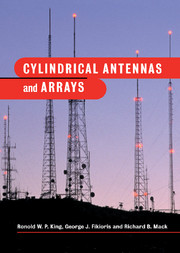Book contents
- Frontmatter
- Contents
- Preface
- Preface to first edition
- 1 Introduction
- 2 An approximate analysis of the cylindrical antenna
- 3 The two-element array
- 4 The circular array
- 5 The circuit and radiating properties of curtain arrays
- 6 Arrays with unequal elements: parasitic and log-periodic antennas
- 7 Planar and three-dimensional arrays
- 8 Vertical dipoles on and over the earth or sea
- 9 Dipoles parallel to the plane boundaries of layered regions; horizontal dipole over, on, and in the earth or sea
- 10 Application of the two-term theory to general arrays of parallel non-staggered elements
- 11 Resonances in large circular arrays of perfectly conducting dipoles
- 12 Resonances in large circular arrays of highly conducting dipoles
- 13 Direct numerical methods: a detailed discussion
- 14 Techniques and theory of measurements
- Appendix I Tables of Ψd R, T(m) or T′(m) and self-and mutual admittances for single elements and circular arrays
- Appendix II Tables of matrix elements Φu and Φυ for curtain arrays
- Appendix III Tables of admittance and impedance for curtain arrays
- References
- List of symbols
- Index
4 - The circular array
Published online by Cambridge University Press: 07 August 2009
- Frontmatter
- Contents
- Preface
- Preface to first edition
- 1 Introduction
- 2 An approximate analysis of the cylindrical antenna
- 3 The two-element array
- 4 The circular array
- 5 The circuit and radiating properties of curtain arrays
- 6 Arrays with unequal elements: parasitic and log-periodic antennas
- 7 Planar and three-dimensional arrays
- 8 Vertical dipoles on and over the earth or sea
- 9 Dipoles parallel to the plane boundaries of layered regions; horizontal dipole over, on, and in the earth or sea
- 10 Application of the two-term theory to general arrays of parallel non-staggered elements
- 11 Resonances in large circular arrays of perfectly conducting dipoles
- 12 Resonances in large circular arrays of highly conducting dipoles
- 13 Direct numerical methods: a detailed discussion
- 14 Techniques and theory of measurements
- Appendix I Tables of Ψd R, T(m) or T′(m) and self-and mutual admittances for single elements and circular arrays
- Appendix II Tables of matrix elements Φu and Φυ for curtain arrays
- Appendix III Tables of admittance and impedance for curtain arrays
- References
- List of symbols
- Index
Summary
The two-element array, which was investigated in the preceding chapter, may be regarded as the special case N = 2 of an array of N elements arranged either at the vertices of a regular polygon inscribed in a circle, or along a straight line to form a curtain. Owing to its greater geometrical symmetry, the circular array is advantageously treated next. Indeed, the basic assumptions which underlie the subsequent study of the curtain array (Chapter 5) depend for their justification on the prior analysis of the circular array.
The real difficulty in analyzing an array of N arbitrarily located elements is that the solution of N simultaneous integral equations for N unknown distributions of current is involved. Although the same set of equations applies to the circular array, they may be replaced by an equivalent set of N independent integral equations in the manner illustrated in Chapter 3 for the two-element array. Since the N elements are geometrically indistinguishable, it is only necessary to make them electrically identical as well. One way is to drive them all with generators that maintain voltages that are equal in amplitude and in phase. When this is done all N currents must also be equal in amplitude and in phase at corresponding points. But this is only one of N possibilities.
- Type
- Chapter
- Information
- Cylindrical Antennas and Arrays , pp. 79 - 111Publisher: Cambridge University PressPrint publication year: 2002



